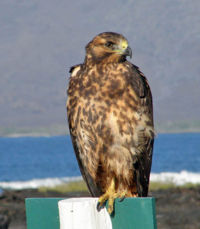Bird Of Prey
 From Conservapedia
From Conservapedia | Bird of Prey | |
|---|---|

| |
| Galapagos Hawk Buteo galapagoensis | |
| Scientific classification | |
| Kingdom Information | |
| Domain | Eukaryota |
| Kingdom | Animalia |
| Subkingdom | Bilateria |
| Branch | Deuterostomia |
| Phylum Information | |
| Phylum | Chordata |
| Sub-phylum | Vertebrata |
| Infraphylum | Gnathostomata |
| Class Information | |
| Superclass | Tetrapoda |
| Class | Aves |
| Population statistics | |
Bird of prey is the generic term for birds within the orders of Accipitriformes, Falconiformes, and Strigiformes, and characterized by the active hunting and killing of prey animals with their feet.
Description[edit]
Although not closely related, members of these three orders share similar characteristics which enable them to be successful hunters. Both have extremely powerful vision, enabling hawks to see rabbits with clarity at distances greater than a quarter of a mile, or in owls to detect a mouse in near-total darkness. Both possess hooked bills made for tearing flesh. And both possess talons capable of killing their prey as soon as a strike is made.
Families[edit]
Accipitriformes and Falconiformes are daylight (diurnal) hunters, consisting of five families and more than 200 species:
- Accipitridae
- Eagles, hawks, harriers, kites, Old World vultures.
- Cathartidae
- Condors, New World vultures.
- Pandionidae
- Osprey.
- Sagittariidae
- Secretary bird.
Falconiformes
- Falconidae
- Falcons, caracaras.
Strigiformes are nocturnal, hunting mainly at night, and consist of two families and more than 120 species:
- Strigidae
- Typical owls.
- Tytonidae
- Barn and bay owls.
Previously, families of this order - including falcons - were placed within the order Falconiformes. Recent studies based on DNA analysis[1], however, have led ornithologists conclude that falcons are more closely related to parrots and passerine birds than they are to hawks and eagles, resulting in a split away from the Accipitriformes, and the transferring of the name Falconiformes exclusively to falcons and caracaras. Even then, Falconiformes is still used for the group as a whole; one study indicated the monophyly is still uncertain, and retains the original name - and falcons - within the order[2].
The family Cathartidae has sometimes been placed within the order Ciconiiformes, due to observations that these birds are related to storks, and indicated by the Sibley-Ahlquist (1990, 1993) classification based on DNA hybridization[3]. This approach has never been unanimous among ornithologists, and further genetic studies would support that opinion[4]. Rather than a family within either Accipitriformes or Ciconiiformes, a separate order, Cathartiformes, is sometimes used.
References[edit]
- ↑ http://www.museum.lsu.edu/~Remsen/SACCprop383.htm
- ↑ https://watermark.silverchair.com/auk0787.pdf?token=AQECAHi208BE49Ooan9kkhW_Ercy7Dm3ZL_9Cf3qfKAc485ysgAAAjwwggI4BgkqhkiG9w0BBwagggIpMIICJQIBADCCAh4GCSqGSIb3DQEHATAeBglghkgBZQMEAS4wEQQMTD14cyMyFz_KJYGtAgEQgIIB7-KeES-6mzwgZV0G9nAvsjG6klWgfpYh75Fk55RbOfeigf_UbRivGWYKan8KzUClX8nEJDcKZqZwC8Q1vOkH0zPKLMet8yXLBEIUEKD_y6-vXrpxExYaagERxTqAsNxGOP3S3V5ulkaeYqKiUdV5ZniF_85LWUHsKaU_S0ZVAXBkplIaPkT3BnLA6lrby2qe8XH8fDvQT4P9c_yp3E_E5K-SRu1APbq3BUgxnaI7zC242UKWNdGU_-mVT3RT1sSrqwDEHGzG-2qsCzhiAW3arEv_lqe_vCxUJXGR2JeN3A1xaeGRqB0mWjeyokkYYn-TRAWYhp5BVJsDS7rUfGSi-yt534vZkUKIVMQgeP0GKNSZZCoPOSc-AePAlRI1Zh0S5dM_QfNL96ayGv-cMBKs7SDcR3Oj9k5DBD1kP31qil3sLD2fFIaK7LNx3ue0NNSQEoo-t8S8_GCObwBaMYUIOMxVd0n8Er7jteM4I_zR6Od7cJpO8YIepoTc8HSp_5LkIVuFlfIz2RIoQxNFQxks_STrPyMSX-o9Fi6rvJOGAUyrCQhNIytimYjI6NPyC2gKiJv_iW6N7R8mATOvr7focAcG3OgUYx_OPXPskXrZ-2q1Q6qulR4z3BQ-pt22OHIiVdR_4iyEZHxEfVY6Fjo_tQ
- ↑ https://digilander.libero.it/avifauna/classificazione/sequence5.htm
- ↑ http://www.museum.lsu.edu/~Remsen/SACCprop241.htm
Categories: [Birds]
↧ Download as ZWI file | Last modified: 02/17/2023 06:33:37 | 36 views
☰ Source: https://www.conservapedia.com/Bird_of_prey | License: CC BY-SA 3.0
 ZWI signed:
ZWI signed: KSF
KSF